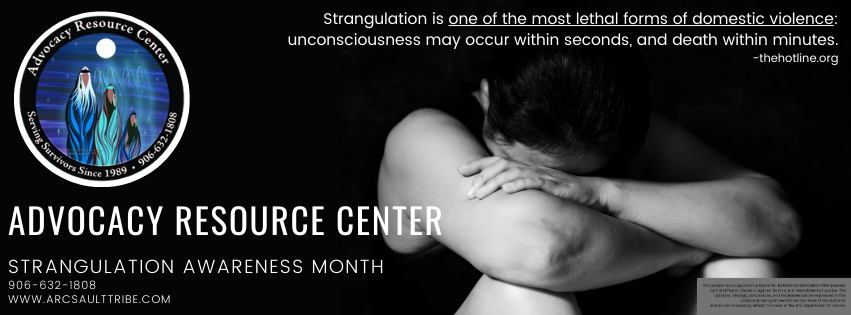November is Strangulation Awareness Month

Strangulation Awareness for November The Advocacy Resource Center is recognizing
November as Strangulation Awareness Month.
Strangulation is a lethal form of assault that can kill a person within minutes. Strangulation is not to be confused with “choking.” Strangulation is described as pressure being applied from the outside, cutting off airflow and blood vessels in the neck, preventing oxygen from reaching the brain. Choking, meanwhile, refers to a blockage or obstruction inside the throat, making breathing difficult. According to the Centers for Disease Control and Prevention (CDC), between 2003 and 2014, 55.3% of female homicide victims in the United States were the result of intimate partner violence (IPV).
The CDC also reports that nearly one in four adult women and approximately one in seven adult men report having experienced severe physical violence, including strangulation, from an intimate partner in their lifetime. According to the 2015 National Intimate Partner and Sexual Violence Survey (NISVS), 21.4% of female respondents have experienced severe physical violence in their lifetime.” (americannurse.com) Strangulation is a significant warning sign for lethality in domestic violence cases. Perpetrators often use strangling as a form of power and control over their intimate partner. Pressure placed upon the victim’s throat can cause unconsciousness and death. Strangulation is just below homicide on the continuum of domestic violence risk assessment. It has been reported that a woman who has survived strangulation by her partner is eight times more likely to die by his hand in another attack. “The odds for homicide via strangulation increase by 750% for victims who have been strangled previously compared to victims who have never been strangled”. (strangulationprevention.com)
Strangulation is relatively easy to identify as many symptoms occur in the facial areas. Some common visible signs of strangulation include petechiae (red spots) in the eyes or the whites of the eyes may be filled with blood, swollen lips, droopy eyelids, facial drooping or swelling, scratch marks to neck or face, raspy or hoarse voice, trouble swallowing, drooling, petechiae on earlobes, bruising on or bleeding from ears, swollen tongue, and/or bumps on head from falling or blunt force trauma. Some signs that a victim may suffer from are not visible, such as intense pain, vision changes, ringing in the ears, cuts in the mouth, swelling of the neck or throat, difficulty breathing, and/or voice changes.
Strangulation may not cause death immediately and has been known to cause death several days later due to collapsed trachea and/or tracheal damage. Strangulation can cause serious health issues and psychological problems. Data on strangulation reveals a harsh picture of the severity of this kind of assault. One in four women will experience intimate partner violence in her lifetime. Of those, up to 68 percent will suffer near-fatal strangulation at the hands of their partner.
It is important also to note other forms of oxygen restriction which may lead to death or brain injury. (healthline.com)
- Suffocation is a general term indicating death caused by a reduction of the oxygen content in inspired air. For example, placing a plastic bag over one’s head is a form of suffocation.
- Smothering is another form of suffocation, in which air (oxygen) is prevented from reaching the lungs by obstructing the nose and the mouth. Abusers may use their hand or a pillow and press it firmly over the victim's face. Facial injuries usually indication smothering.
- Gagging, obstructing the mouth with a cloth or an object. While breathing is possible through the nose, if secretions accumulate in the nose, asphyxia (suffocation) may occur.
- Ligature strangulation, restricting air to lungs by use of rope, wire, or cloth
- Hanging, a form of self-induced suffocation where the body weight causes pressure on the neck to restrict breathing
- Drowning, a form of suffocation, and often used as a fatal term in which a victim dies via submersion and inhalation of water or other liquid
If you have experienced any of these variations of oxygen restriction, please consider reporting the incident to the police. The Advocacy Resource Center can assist with court accompaniment, victims' rights, and referrals to community partners for further assistance. Advocates are available to assist you and can be reached by calling 906-632-1808. If you are ready to leave your situation and need shelter services, you can call and screen for the Lodge of Bravery Shelter at the same phone number 24 hours a day, 7 days a week.
Michigan law states that any person who assaults another person by strangulation or suffocation is guilty of a felony punishable by imprisonment for up to 10 years or a fine of up to $5,000 or both. The law defines “strangulation or suffocation” as “intentionally impeding normal breathing or circulation of the blood by applying pressure on the throat or neck or by blocking the nose or mouth of another person.” Under the law, it is not necessary for a victim to suffer any actual injury for the State to charge a person with assault by strangulation. An aggressor’s intent may be inferred simply from physical violence. (legislature.mi.gov/) If you are a victim of strangulation and would like advocacy, please contact the Advocacy Resource Center at 906-632-1808. You are not alone. There is help.